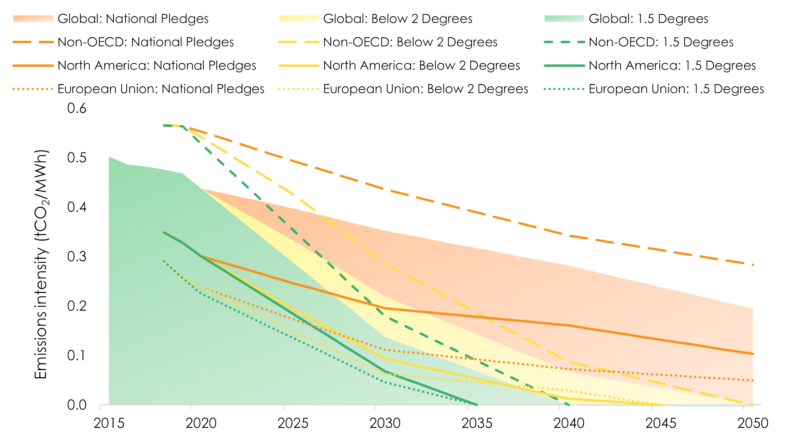How can climate assessment tools support investment in emerging markets?

Antonina Scheer and Carmen Nuzzo outline the challenges of assessing the decarbonisation pathways of companies operating in emerging markets and developing countries, and present possibilities for adopting a more nuanced and equitable approach to climate finance strategies.
The aim to make “finance flows consistent with a pathway towards low greenhouse gas emissions and climate-resilient development” is an important element of the Paris Agreement. Such flows must come from both the private and public sectors. As part of the global drive to net zero, there is a particular need to increase financing for climate action in emerging markets and developing countries (EMDCs): according to the Independent High-Level Expert Group on Climate Finance, international private finance to EMDCs must increase fifteen-fold to achieve the low-carbon transition.
As more financial institutions commit to net zero targets, rigorous and consistent climate assessments of financed entities will be needed, tailored to specific regional circumstances. This will be a key enabler for ramping up private climate finance globally. Yet, the tools currently available are not sufficiently nuanced, especially when it comes to their suitability for EMDCs.
Current methods for assessing companies’ climate performance – and their geographical limitations
Corporate climate assessments typically qualitatively evaluate climate governance practices and quantitatively assess their emissions pathways. The latter requires:
- an entity’s historical and current emissions performance;
- projections of its future emissions, e.g. based on stated targets; and
- a modelled sector-specific benchmark that an entity needs to follow to be consistent with a given global temperature scenario.
Sector-specific benchmarks typically rely on modelled low-carbon scenarios, such as those in the AR6 Scenario Explorer of the Intergovernmental Panel on Climate Change (IPCC) or those developed by the International Energy Agency (IEA). The carbon budget associated with a given emissions scenario – i.e. the quantity emissions that can be released before breaching the relevant temperature threshold – can be allocated to specific categories (e.g. sectors or regions) in a cost-effective way, considering differences in mitigation potential, emissions intensities and the costs of low-carbon technologies.
Drawing on scenarios that include sectoral emissions and activity data, the Transition Pathway Initiative Centre (TPI Centre) assesses the alignment of the world’s largest companies in high-emitting sectors using the Sectoral Decarbonisation Approach (SDA). The Science Based Target Initiative (SBTi), which validates corporate net zero targets, also uses this approach.
However, assessing corporate emissions against these sectoral benchmarks can obscure the unique circumstances of countries or regions. This is particularly relevant for EMDCs, which generally have low cumulative historical emissions but more emissions-intensive assets today, due to a greater reliance on fossil fuels compared with many developed countries. EMDCs also face the challenge of higher costs of capital and competing funding needs for economic development.
The need to recognise national differences when evaluating climate action is enshrined in the UN Framework Convention on Climate Change, which states that climate action should be undertaken in accordance with countries’ ‘common but differentiated responsibilities and respective capabilities’. A related factor is cost-efficiency, which is important for making the costs of the low-carbon transition affordable, especially in low-income countries. While EMDCs can take advantage of many low-cost climate mitigation opportunities, the high emissions intensity of some sectors and activities means that they may need more time to meet Paris-aligned benchmarks. Equity and cost-efficiency considerations can therefore cause significant regional differences in decarbonisation trajectories.
With a lack of regional nuance in typical climate assessments, investors may decide to withdraw from high-emitting EMDCs in order to decarbonise their investment portfolios. This is a problem as it could constrain the financial flows needed for the low-carbon transition.
What can investors do to better recognise emerging market circumstances?
Suggestions are emerging for how investors can consider climate finance and development challenges together. Here, we offer three ways in which investors can begin to incorporate a regional lens into their climate finance strategies – and explain how TPI Centre tools can support this endeavour.
1. Apply exemptions to entities operating in certain regions or countries
Companies that operate entirely or primarily in EMDCs could be exempted from the most ambitious qualitative climate governance indicators, such as having to ensure consistency between a company’s climate change policy and the positions taken by trade associations it belongs to. This is one of the indicators companies must meet to achieve the top rating under the TPI Centre’s Management Quality framework, which evaluates and tracks companies’ emissions governance. Another option is to introduce grace periods for achieving benchmark alignment to account for the higher-emissions starting point of some companies based in emerging markets.
In the case of country assessments, exemptions for lower income groups can be made on the most ambitious climate performance indicators. For example, the ASCOR tool, which assesses countries’ climate targets and policies, exempts low-income countries from the requirement to establish carbon pricing.
However, while exemptions offer a clear way to recognise the additional challenges faced by EMDCs, they must be used carefully to avoid delaying the global low-carbon transition.
2. Use regional emissions benchmarks
In a small number of sectors, importantly including electricity, the IEA disaggregates emissions scenarios into OECD and non-OECD countries and into regional groups. However, for most sectors, granular scenario data and thus benchmarks are lacking at the regional level. As electricity is not a globally traded commodity and utilities tend to operate locally, regional benchmarks are a useful tool for recognising the differing decarbonisation challenges of utilities operating around the world.
The TPI Centre has developed a regional approach to assessing the carbon performance of electricity generation with benchmarks that recognise the higher emissions-intensity starting point of the power grid in non-OECD countries compared with those of Europe and North America (see Figure 1). In line with the principle of ‘common but differentiated responsibilities’, these benchmarks require companies operating in wealthier industrialised regions to have lower emissions intensities and reach net zero sooner.
Figure 1. Carbon Performance benchmarks for the electricity sector

Regional benchmarks that are developed based on cost-efficient modelled scenarios, including those of the IEA, are not designed to guarantee equitable outcomes. For example, in some of the IPCC’s 1.5°C scenarios, Latin America reaches net zero as early as 2045 while Europe does so later, in 2060. Although this may be inequitable when considering regional wealth and historical responsibility for climate change, the difference results from the assumptions inherent in cost-optimisation models. For example, such models assume a harmonised global carbon price and large international transfers to finance carbon removal in areas with high reforestation potential. Furthermore, many regional models group countries of varying income levels and development histories into a single region. These factors may limit the usefulness of regional benchmarks to investors interested in equity considerations.
An alternative to cost-efficient models for regional disaggregation is equity-weighted ‘fair share’ emissions allocations. This approach is adopted in the ASCOR tool and by Climate Action Tracker. Fair shares are based on ethical and political considerations, and therefore may have limited use for evaluating companies, particularly multinational corporations.
3. Evaluate corporate entities within their policy contexts
Country and company analyses of climate risks can be cross-referenced to better understand how companies are performing in relation to the local regulatory conditions in which they operate. Such an analysis would consider country-specific features, including economic structure, state ownership of key entities and the dominance of certain industries. The TPI corporate tool and the sovereign ASCOR tool can be used jointly for this purpose, for example.
Blunt approaches such as coal exclusion policies or a singular focus on reducing financed emissions could systemically impact the economy of a country that currently relies on emissions-intensive activities. Investors should adjust their expectations of high-emitting companies by considering country circumstances and develop tailored, place-based engagement strategies. Going beyond requests for company disclosure of emissions and targets, investors should build a dialogue informed by detailed insights of company business models, their ability to transition, wider trends and the economic importance of emissions-intensive sectors in a given country.
Embracing complexity
To loosen the historical deadlock on international climate finance and enable a just and climate-resilient low-carbon transition, it is crucial to put the principle of ‘common but differentiated responsibilities’ into practice and make the transition affordable in emerging economies.
Although the need for regional benchmarks and improved modelling data is clear, investors must integrate equity into climate finance through a multi-faceted approach. Even if more detailed regional benchmarks existed, investors would still need to draw on complementary resources. The three approaches highlighted in this commentary are a good starting point and represent possible routes to drive finance to where it is most needed, to ensure a truly global transition.
The authors would like to thank Simon Dietz for his review of this commentary.
This commentary draws on research conducted within the Transition Pathway Initiative Centre (TPI Centre) based at the Grantham Research Institute on Climate Change and the Environment. The TPI Centre uses public disclosure to evaluate companies on two pillars: Management Quality and Carbon Performance. The TPI Centre also assesses sovereigns against the Assessing Sovereign Climate-related Opportunities and Risks (ASCOR) framework, provides the data for Climate Action 100+, and assesses banks against the TPI Net Zero Banking Assessment Framework.

